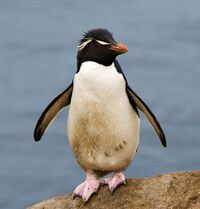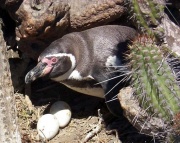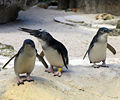Penguin
| Penguin | |
|---|---|

| |
| Rockhopper Penguin Eudyptes chrysocome | |
| Scientific classification | |
| Kingdom Information | |
| Domain | Eukaryota |
| Kingdom | Animalia |
| Subkingdom | Bilateria |
| Phylum Information | |
| Superphylum | Deuterostomia |
| Phylum | Chordata |
| Sub-phylum | Vertebrata |
| Infraphylum | Gnathostomata |
| Class Information | |
| Superclass | Tetrapoda |
| Class | Aves |
| Sub-class | Neornithes |
| Infra-class | Neognathae |
| Order Information | |
| Order | Spheniciformes |
| Family Information | |
| Family | Spheniscidae |
| Genus Information | |
| Genera | Aptenodytes Eudyptes Eudyptula Megadyptes Pygoscelis Spheniscus |
| Population statistics | |
Penguins are flightless birds that belong of the class called Aves. Birds are generally characterized by having an outer covering of feathers and being warm blooded. Their are about 17 different species of penguins, which are located exclusively in the Southern Hemisphere. However, contrary to popular beliefs, penguins are not just found in cold climates.
Anatomy
Penguins range in shape and size. The largest penguin, is the emperor penguin standing 3.7 ft. and weighing 60-90 lbs. The smallest is the fairy penguin; it stands at 16 in and weighs only 2.2 lbs. Penguins are black and white but sometimes have yellowish- orange markings on them. Penguins mouths are lined with spiny, rear-directed spines to help when swallowing live prey. Penguins seem to have a lot more feathers than other birds, with about 70 feathers per square inch.
Penguins are uniquely designed for the water. The darker and lighter colors are a way of protection for the penguins, when in the water looking up at the underside it is a lighter color and matches the sky and light above it, and when looking down on it you see darkness like the bottom of the ocean. They have large heads, short necks, and elongated bodies, which helps them with swimming. A penguin's feet are webbed and are set far back on its body, to help it to stand up right when on land.
Entymology
Penguins were discovered with the great explorations of the 16th century, as European sailors pushed southward into the Atlantic Ocean. The first species of penguin they may have encountered was the gentoo penguin (Pygoscelis papua), which inhabits Patagonia, the Falkland Islands and South Georgia. The similarity in shape, habits, and coloration to a bird they had already known as the penguin - the extinct great auk (Pinguinus impennis) - was striking, hence the transfer of the name. The word is possibly based upon the Welsh pen gwyn,[1] referring to the white eye patch on the head of the auk; or upon pin-wing, in reference to the rudimentary wings on both birds.
Reproduction
Penguins reproduce sexually, and reach sexual maturity from 3 to 8 years. The normal breeding time for penguins is spring through summer. Courtship varies among the species, It begins with both visual and vocal displays, Many males display first to establish a nest site and then to attract a a female. Most penguins only have one partner during the season but sometimes a female penguin will have up to 3. The female penguins compete for the males and they are the one who choose their mates. Penguins lay eggs, their eggs may be white to blue or green. The nest that holds the eggs is called a clutch and normally only contains 2 eggs. The male is the one who protects the eggs, he will keep it on his feet for the months before it hatches.
Ecology
Penguins are considered some of the most social of birds. Communication involves a variety of physical or "displays". Penguins eat krill, squids, and fish. Some of the smaller penguins eat only krill (a tiny shrimp-like animal). Some penguins will chase after Rock Crabs also.
The different species of Penguins live in a variety of areas throughout the Southern Hemisphere including the Antarctic continent. They have managed to successfully adapt and colonize one of the lowest temperature climates on earth, reaching as low as -140 degrees Fahrenheit.
Phylogeny
- Family Spheniscidae
- Subfamily Spheniscinae
- Genus Aptenodytes
- Emperor penguin, Aptenodytes forsteri
- King penguin, Aptenodytes patagonicus
- Genus Eudyptes
- Chatham penguin, Eudyptes chathamensis (extinct)
- Eastern rockhopper penguin, Eudyptes filholi
- Erect-crested penguin, Eudyptes sclateri
- Fiordland crested penguin, Eudyptes pachyrynchus
- Macaroni penguin, Eudyptes chrysolophus
- Northern rockhopper penguin, Eudyptes moseleyi
- Royal penguin, Eudyptes schlegeli
- Snares crested penguin, Eudyptes robustus
- Western rockhopper penguin, Eudyptes chrysocome
- Genus Eudyptula
- Little penguin, Eudyptula minor
- Genus Megadyptes
- Waitaha penguin, Megadyptes waitaha (extinct)
- Yellow-eyed penguin, Megadyptes antipodes
- Genus Pygoscelis
- Adelie penguin, Pygoscelis adeliae
- Chinstrap penguin, Pygoscelis antarctica
- Gentoo penguin, Pygoscelis papua
- Genus Spheniscus
- African penguin, Spheniscus demersus
- Galapagos penguin, Spheniscus mendiculus
- Humboldt penguin, Spheniscus humboldti
- Magellanic penguin, Spheniscus magellanicus
- Genus Aptenodytes
Gallery
Emporer Penguin
(Aptenodytes forsteri)Fairy Penguin
(Eudyptula minor)



